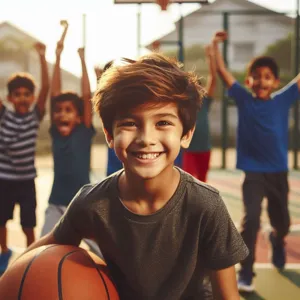In the world of basketball, success is often measured by points on the scoreboard, yet the true essence of the game transcends mere statistics.
Cultivating a positive attitude towards basketball can significantly impact not only performance on the court but also personal growth and team dynamics. Whether you’re a seasoned player aiming for the championship or a newcomer looking to embrace the sport, the mindset you bring to the game is crucial. It shapes your resilience in the face of challenges, enhances your enjoyment of the sport, and fosters stronger connections with teammates. In this blog post, we’ll explore practical strategies and inspiring insights to help you develop a winning mindset, overcome self-doubt, and truly enjoy every dribble, pass, and shot. Join us as we dive into the importance of positivity in basketball and how it can propel you towards success—both in the game and in life.
1. Understanding the Importance of a Positive Attitude in Sports

A positive attitude in sports is more than just a mental state; it’s a powerful catalyst that can influence performance, teamwork, and overall enjoyment of the game. Basketball, with its fast-paced nature and the necessity for split-second decisions, is particularly sensitive to the emotional climate of the players. When athletes approach the court with optimism and confidence, they not only enhance their own performance but also uplift their teammates, creating a more cohesive and supportive environment.
Research has shown that maintaining a positive outlook can lead to improved resilience. In basketball, setbacks are inevitable—missed shots, turnovers, and losses are all part of the game. However, athletes with a positive mindset are more likely to view these challenges as opportunities for growth rather than as insurmountable obstacles. They learn to embrace failure as a stepping stone to success, using each experience to refine their skills and strategies.
Moreover, a positive attitude fosters better communication on and off the court. Players who encourage one another and maintain a constructive dialogue create an atmosphere where everyone feels valued and motivated. This camaraderie not only enhances team dynamics but also significantly impacts overall performance. When players feel supported, they are more likely to take risks, push their limits, and work collaboratively towards a common goal.
In addition to team benefits, a positive attitude can deeply affect an individual’s love for the game. Basketball should be enjoyable, and when players approach it with enthusiasm and joy, their passion shines through. This infectious energy can inspire both current teammates and future players, creating a cycle of positivity that reverberates throughout the basketball community.
Ultimately, understanding the importance of a positive attitude in sports is crucial for anyone looking to enhance their basketball journey. By cultivating this mindset, players not only set themselves up for individual success but also contribute to a thriving, supportive environment that elevates the game for all involved.
2. The Mindset Shift: From Fear of Failure to Embracing Challenges
In the realm of basketball, the difference between a good player and a great one often lies not just in skill, but in mindset. The transition from fearing failure to embracing challenges is a pivotal shift that every aspiring player must undertake. Fear of failure can be paralyzing; it manifests as anxiety before a game, hesitation during a crucial play, or an aversion to taking risks. This mindset can inhibit performance and stifle growth, leading players to play it safe rather than pushing their limits.
Conversely, embracing challenges transforms the game into an opportunity for growth. When players shift their focus from the fear of missing a shot to the excitement of learning from each experience, they open themselves up to a world of possibilities. Every missed shot becomes a lesson, every lost game an opportunity to analyze and improve. This approach fosters resilience, enabling players to bounce back stronger after setbacks.
To cultivate this positive attitude, it’s essential to create an environment that rewards effort over perfection. Celebrate small victories, such as a well-executed play or a particularly gritty defensive stance. Encourage teammates to share their experiences and insights, creating a supportive culture where everyone feels comfortable taking risks. Visualization techniques can also be powerful tools; by envisioning success and positive outcomes, players can rewire their thinking, replacing fear with confidence.
Ultimately, the mindset shift from fearing failure to embracing challenges not only enhances performance on the court but also instills valuable life skills. Players learn to approach obstacles with determination, fostering a lifelong passion for growth and improvement. In basketball, as in life, it’s not about avoiding failure; it’s about daring to take the shot.
3. Setting Realistic Goals for Personal and Team Success

Setting realistic goals for both personal and team success is a crucial element in cultivating a positive attitude towards basketball. It’s easy to become overwhelmed by lofty aspirations—dreaming of becoming the next basketball superstar or leading your team to an undefeated season can be motivating, but without a clear, achievable path, such dreams can quickly lead to frustration and disappointment.
Start by breaking down your larger goals into smaller, manageable milestones. For instance, if your ultimate aim is to improve your shooting percentage, focus on specific areas like perfecting your free throw technique or increasing your three-point shots during practice sessions. Track your progress over time; celebrating these incremental successes can boost your confidence and reinforce your commitment to improvement.
On a team level, set collective goals that everyone can contribute to and rally around. This might include improving communication on the court, enhancing teamwork through regular practice drills, or aiming to win a certain number of games in a season. Make sure these goals are realistic and consider the strengths and weaknesses of your team. By fostering a shared vision, you’ll not only build camaraderie among teammates but also create a supportive environment that encourages every player to strive for excellence.
Moreover, regularly revisit and adjust your goals as needed. Basketball is a dynamic sport, and evolving circumstances can necessitate shifts in strategy and focus. By remaining flexible and open-minded, you can maintain a positive attitude, even in the face of challenges. Remember, the journey towards success is just as important as the destination. Embrace every step along the way, and watch as both your skills and your team’s performance flourish.
4. Visualization Techniques: Imagining Success on the Court
Visualization techniques are a powerful tool that can significantly enhance your performance on the basketball court. Athletes across all levels have harnessed the power of mental imagery to improve their skills, boost their confidence, and cultivate a winning mindset. By visualizing success, you create a mental blueprint of how you want to perform, allowing your brain and body to work in harmony when it matters most.
To begin, find a quiet space where you can relax and concentrate. Close your eyes and take a few deep breaths to clear your mind of distractions. Picture yourself stepping onto the court, feeling the familiar texture of the basketball in your hands and the weight of your jersey on your shoulders. Imagine the roar of the crowd, the smell of the polished wood floor, and the sound of sneakers squeaking against it. Engaging all your senses in this mental rehearsal makes the experience feel more real.
Next, visualize specific game scenarios—perhaps it’s a crucial free throw in the final seconds or a fast break leading to a layup. See yourself executing each movement with precision: the way you dribble, the angle of your shot, and the follow-through that sends the ball soaring through the air and swishing through the net. Picture the confidence radiating from your body as you make these plays successfully. This vivid imagery not only boosts your self-belief but also helps your brain create new neural pathways that prepare you for real-game situations.
Incorporate this practice into your daily routine. Whether you dedicate ten minutes each morning or a few moments before you sleep, the consistent repetition of positive imagery can reinforce your skills and foster a resilient mindset. Over time, you’ll find that visualizing success on the court translates into improved focus, better decision-making, and ultimately, enhanced performance. By making visualization a key part of your training regimen, you’re setting yourself up for success, both mentally and physically, in the exhilarating game of basketball.
5. The Role of Self-Talk in Building Confidence

Self-talk plays a pivotal role in shaping an athlete’s mindset, especially in a high-pressure sport like basketball. The conversations you have with yourself can either propel you toward greatness or hold you back from reaching your full potential. Positive self-talk is the fuel that ignites confidence, helping you to overcome doubts and embrace challenges on the court.
Imagine standing at the free-throw line with the game on the line. Your heart races and the weight of expectation hangs heavily in the air. In these moments, the words you whisper to yourself can make all the difference. Instead of succumbing to panic or negativity, adopting an encouraging internal dialogue can shift your focus. Phrases like “I’ve practiced for this” or “I am capable of making this shot” reinforce your skills and remind you of your hard work and preparation.
Studies have shown that athletes who engage in positive self-talk experience lower levels of anxiety and higher levels of performance. This mental strategy helps to create a constructive mindset, fostering resilience against the inevitable ups and downs of the game. By deliberately choosing affirming statements, you can build a mental environment where confidence flourishes.
Incorporating self-talk into your pre-game routine can also set the tone for success. Whether it’s visualizing a successful performance or reciting mantras that resonate with your goals, these practices help prime your mind for the challenges ahead. Remember, basketball is as much a mental game as it is a physical one. By cultivating a habit of positive self-talk, you not only enhance your performance but also nurture a more enjoyable and fulfilling basketball experience. Embrace the power of your words, and watch as your confidence soars on the court.
6. Learning from Setbacks: Turning Losses into Learning Opportunities
In the world of basketball, setbacks are an inevitable part of the journey. No player, no coach, and no team can claim a flawless record; losses are as integral to the game as victories. However, it’s the approach to these setbacks that can set successful players apart from the rest. Instead of viewing a loss as a failure, embrace it as a golden opportunity for growth and development.
Consider the moments following a tough game. The initial sting of disappointment can be hard to shake off, but it’s crucial to pivot your perspective. Take the time to analyze what went wrong: Was it a lack of communication on the court? Did you struggle with your shooting accuracy? Perhaps the team’s defense faltered at critical moments? By dissecting these elements, you gain valuable insights into areas that need improvement.
Journaling can be a powerful tool in this process. After each game, jot down your thoughts—what you felt went well, what didn’t, and what you can do differently next time. This reflective practice not only helps in identifying specific skills to work on but also fosters a mindset of resilience. Remember, every great player has faced their share of defeats; it’s how they responded that truly defined their careers.
Moreover, discussing these setbacks with teammates or mentors can provide additional perspectives and encouragement. Engaging in constructive dialogue can lead to collective learning and strengthen team dynamics, turning individual losses into shared experiences that foster unity and motivation.
Ultimately, the key is to cultivate a mindset where setbacks are seen as stepping stones rather than stumbling blocks. By turning each loss into a lesson and maintaining a positive attitude, you not only enhance your skills but also instill a sense of perseverance that will serve you well throughout your basketball journey. Embrace the process, learn from the lessons, and keep shooting for success.
7. The Impact of Positive Relationships with Coaches and Teammates

The impact of positive relationships with coaches and teammates cannot be overstated when it comes to cultivating a successful mindset in basketball. The basketball court is not just a physical arena; it’s a dynamic environment where emotional connections play a crucial role in both personal and team development. When players share a respectful and encouraging bond with their coaches, they are more likely to embrace constructive criticism and feel motivated to push their limits. Coaches who invest time in understanding each player’s strengths and weaknesses foster an atmosphere of trust and open communication, allowing athletes to ask questions without fear of judgment.
Similarly, strong relationships among teammates can significantly enhance team cohesion and performance. When players support each other, celebrate successes, and work through challenges together, they create a sense of belonging that is vital for individual and collective growth. On the court, this translates to seamless teamwork, where players instinctively know where their teammates will be, leading to better passes, smarter plays, and ultimately, a more successful game.
Moreover, the camaraderie built through shared experiences—be it rigorous practices, exhilarating victories, or tough losses—breeds resilience. Positive relationships help players navigate the emotional ups and downs of the sport, reinforcing their commitment to both personal and team goals. In essence, fostering a culture of positivity within the team not only enhances performance but also cultivates a lifelong love for the game. Whether through a simple pat on the back after a tough play or an uplifting word during a challenging practice, these relationships are the foundation upon which great players and teams are built.
8. Incorporating Mindfulness and Focus into Your Game
Incorporating mindfulness and focus into your basketball game can be a game-changer, both on and off the court. As the pace of the game quickens and the pressure mounts, the ability to stay present and fully engaged becomes crucial. Mindfulness allows players to channel their energy effectively, honing in on the task at hand rather than getting lost in the chaos of the game.
Start by integrating mindfulness practices into your pre-game routine. This could involve simple breathing exercises that help center your thoughts and calm your nerves. Close your eyes, take a deep breath, and visualize yourself on the court, executing plays flawlessly. This mental rehearsal not only boosts your confidence but also creates a strong mental image of success that you can draw upon during high-pressure moments.
During practice sessions, make a conscious effort to focus on the fundamentals. Whether it’s perfecting your shooting form or developing your dribbling skills, concentrate intently on each movement. Eliminate distractions by leaving your phone in your bag and tuning out background noise. This intentional focus will enhance muscle memory and improve your overall performance during games.
Once you step onto the court, practice staying in the moment. Instead of worrying about the score or what will happen next, embrace the flow of the game. Pay attention to the sounds—the squeak of sneakers on the hardwood, the bounce of the ball, and the cheers of your teammates. Engaging your senses can ground you, helping to maintain your focus and reduce anxiety.
Finally, develop a post-game routine that encourages reflection and mindfulness. After each game, take a few minutes to evaluate your performance. Consider what went well, what could be improved, and how you felt throughout the game. This practice fosters a growth mindset, allowing you to learn from experiences and approach future games with renewed focus and positivity.
By incorporating mindfulness and focus into your training and gameplay, you not only enhance your performance but also cultivate a deeper love for the sport. As you learn to navigate the challenges of basketball with a clear mind and a positive attitude, you’ll find that your confidence grows, your skills sharpen, and your enjoyment of the game reaches new heights.
9. Developing Resilience: Bouncing Back Stronger
In the world of basketball, resilience is not just a trait; it’s a game-changer. Every player, from the rookie on the court to the seasoned pro, faces setbacks—be it a missed shot in a crucial moment, an unexpected loss, or even an injury that sidelines them. Developing resilience means nurturing the mental fortitude to bounce back stronger after these challenges.
To cultivate this essential quality, start by reframing your mindset. Instead of viewing setbacks as failures, see them as opportunities for growth. Each missed shot or lost game offers invaluable lessons that can inform and improve your skills. Reflect on what went wrong and create actionable steps for improvement. This reflective practice not only enhances your gameplay but also builds a stronger mental approach to future challenges.
Another key aspect of resilience is maintaining a positive support system. Surround yourself with coaches, teammates, and mentors who encourage you to keep pushing through tough times. Their support can provide motivation and perspective, reminding you that every athlete faces hurdles and that perseverance is part of the journey.
Incorporate stress-management techniques into your routine, such as mindfulness or visualization exercises. These practices can help you stay calm and focused under pressure, enabling you to respond to challenges with clarity and confidence.
Remember, resilience is not built overnight; it’s a continuous process. Each time you face a setback and choose to rise again, you’re not just improving your game; you’re fostering a mindset that will serve you well beyond the basketball court. Embrace the journey, learn from your experiences, and let your resilience propel you toward success, both in basketball and in life.
10. Celebrating Small Wins to Foster Motivation
Celebrating small wins is essential in cultivating a positive attitude towards basketball, as it not only boosts motivation but also reinforces a growth mindset. Every dribble, every successful pass, and every point scored, no matter how minor, contributes to the larger journey of improvement. Recognizing these smaller achievements helps players appreciate their progress and keeps them engaged in the game.
Imagine a player who has been working tirelessly on their shooting technique. After countless hours of practice, they finally sink a few consecutive shots during a scrimmage. Instead of dismissing this achievement as insignificant, they take a moment to celebrate. Perhaps they share the moment with teammates, acknowledging the hard work that led to this success, or they treat themselves to a small reward, like their favorite snack after practice. This practice of celebrating small wins creates a positive feedback loop, reinforcing their efforts and encouraging them to continue striving for excellence.
Moreover, celebrating small victories can also build camaraderie among teammates. When players recognize each other’s achievements, it fosters a supportive environment where everyone feels valued. This camaraderie can be as simple as high-fives after a good play or shared laughter during practice. When players celebrate together, they not only motivate each other but also strengthen their bond as a team.
Incorporating celebrations for small wins into training and games can be transformative. Coaches can designate a “Player of the Day” to highlight individual accomplishments or create a point system to reward effort, teamwork, and improvement. By focusing on these smaller milestones, players learn to appreciate the journey they’re on, understanding that every step forward is a building block towards greater success. In basketball, as in life, it’s these small victories that pave the way for larger achievements and foster an enduring love for the game.
11. The Influence of Nutrition and Physical Health on Mental Attitude
Nutrition and physical health play a pivotal role in shaping a positive mental attitude, especially in a demanding sport like basketball. Your body is your most important asset on the court, and what you fuel it with can significantly impact your performance, mood, and overall outlook. Consuming a balanced diet rich in whole foods—such as fruits, vegetables, lean proteins, and whole grains—provides the essential nutrients your body needs to function optimally. This not only supports physical endurance and agility but also contributes to mental clarity and focus.
When you nourish your body adequately, you set the stage for a more resilient mindset. Hydration is equally crucial; even mild dehydration can lead to fatigue, reduced concentration, and irritability. Ensuring you drink enough water before, during, and after games can keep your energy levels high and your spirits lifted.
Moreover, regular physical activity beyond basketball practice—like strength training, flexibility exercises, or even recreational sports—can enhance your mood by releasing endorphins, the body’s natural mood lifters. When you feel physically strong and healthy, you’re more likely to approach challenges with confidence and a positive attitude.
On the flip side, neglecting your nutrition and physical health can lead to feelings of fatigue, frustration, and self-doubt. A poor diet may leave you sluggish on the court, while inadequate exercise can diminish your overall sense of well-being. To cultivate a winning mindset, prioritize your health by making conscious choices about what you eat and how you move. When you treat your body well, you’ll find that your mental attitude shifts towards optimism, resilience, and a drive for success—both in basketball and in life.
12. Creating a Supportive Environment for Success
Creating a supportive environment for success is essential in cultivating a positive attitude towards basketball, both on and off the court. The atmosphere surrounding a player can significantly influence their mindset, performance, and overall enjoyment of the game. Whether you are a coach, parent, teammate, or fan, your role in fostering this supportive environment is crucial.
First and foremost, communication plays a vital role. Encouragement and constructive feedback should be at the forefront of all interactions. Instead of focusing solely on mistakes, celebrate the small victories and improvements. A simple “great effort” or “I see how hard you’re working” can make a world of difference in a young athlete’s confidence. This positive reinforcement helps players understand that growth is a journey filled with ups and downs.
Moreover, building a sense of camaraderie among teammates is essential. Organizing team-building activities outside of practice can strengthen bonds and create a sense of belonging. When players feel connected to one another, they are more likely to support each other during challenging times on the court. Whether it’s a team dinner, a fun outing, or even group chats to share tips and motivational quotes, these experiences help to cultivate a positive team culture.
Additionally, involving parents and guardians in the process can amplify this supportive environment. Hosting workshops or informational sessions where they can learn about the importance of encouragement and sportsmanship can help align everyone’s approach. Parents should be reminded that their role is to cheer, not to critique, allowing players to focus on their game without the pressure of high expectations.
Lastly, creating a physical space that exudes positivity is also crucial. Whether it’s a well-maintained gym, inspiring quotes on the walls, or a dedicated area for player recognition, these elements can enhance the overall experience and motivate players to strive for greatness. When players see that their hard work is acknowledged and valued, they are more likely to embrace challenges with a positive mindset.
In summary, a supportive environment is the backbone of a successful basketball journey. By fostering open communication, encouraging teamwork, engaging parents, and creating a positive physical space, players can thrive both in their skills and their love for the game. Remember, a positive attitude isn’t just about individual success; it’s about uplifting everyone around you, creating a legacy of encouragement and achievement in the world of basketball.
13. Strategies for Maintaining Positivity During Tough Times
Navigating the ups and downs of a basketball season can be challenging, especially when faced with setbacks or disappointing outcomes. Maintaining a positive attitude during these tough times is crucial for both personal growth and team morale. Here are several strategies to help you cultivate resilience and keep your spirits high, even when the going gets tough.
First and foremost, focus on the power of perspective. When a game doesn’t go as planned or a practice feels particularly grueling, take a moment to reflect on what you’ve learned from the experience. Instead of dwelling on the negative aspects, consider how these challenges can shape you into a better player. A missed shot or a loss can be reframed as an opportunity for improvement, fueling your determination to work harder and smarter.
Surrounding yourself with a supportive network can also play a significant role in maintaining positivity. Engage with teammates, coaches, and friends who uplift and encourage you. Share your feelings and experiences, and listen to theirs in return. Building a community that fosters positivity can create a shared sense of purpose, reminding everyone that they are not alone in their struggles.
Incorporating mindfulness techniques can further bolster your mental resilience. Simple practices, such as deep breathing exercises or visualization, can help you stay grounded and focused. Before games or practices, take a moment to visualize your success on the court; imagine the ball swishing through the net, the sound of applause, and the feeling of accomplishment. This mental rehearsal not only boosts your confidence but also helps to channel your energy in a positive direction.
Finally, set achievable goals that allow you to celebrate small victories along the way. Whether it’s improving your free throw percentage, mastering a new play, or enhancing your defensive skills, breaking down your aspirations into manageable milestones can provide a sense of progress and motivation. Acknowledging these achievements, no matter how small, fosters a sense of positivity and encourages a growth mindset that thrives on resilience.
By implementing these strategies, you can cultivate a positive attitude that not only enhances your performance on the court but also enriches your journey as a basketball player. Remember, every setback is just a setup for a comeback, and embracing this mindset will pave the way for continued success.
14. Inspiring Stories of Athletes Who Cultivated a Positive Attitude
Athletics is often as much a mental game as it is a physical one, and the most successful basketball players understand the profound impact a positive attitude can have on their performance. Let’s explore some inspiring stories of athletes who overcame challenges and cultivated a mindset that propelled them to greatness, both on and off the court.
Take the legendary Michael Jordan, for example. Widely regarded as one of the greatest basketball players of all time, Jordan faced significant setbacks early in his career, including being cut from his high school basketball team. Rather than allowing this failure to define him, he embraced it as a catalyst for improvement. His relentless work ethic and unwavering belief in his potential transformed his disappointment into determination. Jordan famously said, “I’ve missed more than 9,000 shots in my career. I’ve lost almost 300 games. Twenty-six times, I’ve been trusted to take the game-winning shot and missed. I’ve failed over and over and over again in my life. And that is why I’ve succeeded.” This perspective not only fueled his rise to stardom but also serves as a powerful reminder to aspiring athletes about the importance of resilience and a positive outlook.
Another remarkable story is that of NBA star Kevin Durant. Throughout his career, Durant has faced both external criticism and personal challenges, including the loss of his close family members. Instead of succumbing to negativity, Durant has used these experiences to foster a deeper appreciation for the game and a commitment to self-improvement. He often speaks about the importance of gratitude, mindfulness, and surrounding himself with supportive people who uplift him. By focusing on the positives, Durant has not only achieved incredible success on the court but also become a strong advocate for mental health awareness in sports, inspiring countless individuals to prioritize their mental well-being.
Similarly, the story of Stephen Curry highlights the transformative power of a positive attitude. Drafted as the seventh overall pick in the 2009 NBA Draft, Curry faced skepticism about his size and playing style. Instead of letting doubt overshadow his ambitions, he worked tirelessly to develop his skills and reshape the game of basketball with his exceptional shooting ability. His mantra, “I can do all things,” exemplifies his belief in personal growth and the importance of maintaining a positive mindset in the face of adversity. Curry’s journey encourages young athletes to embrace their uniqueness and stay committed to their goals, regardless of the obstacles they may encounter.
These athletes exemplify how a positive attitude can be a game-changer, not only for achieving success in basketball but also for overcoming life’s challenges. Their stories remind us that cultivating a positive mindset is essential for anyone looking to reach their full potential, underscoring the notion that success is as much about mental fortitude as it is about talent and skill. By drawing inspiration from their journeys, aspiring basketball players can learn to harness the power of positivity, fueling their passion and propelling them toward their own victories on and off the court.
15. Conclusion: The Lasting Benefits of a Positive Mindset in Basketball and Life
In conclusion, cultivating a positive mindset in basketball extends far beyond the confines of the court; it permeates every aspect of life. The benefits of nurturing positivity are profound and multifaceted, influencing not only performance but also personal growth, resilience, and relationships.
As athletes, embracing a positive attitude can transform challenges into opportunities. It fosters a sense of confidence and determination, enabling players to tackle setbacks with grace and learn from their experiences. This mental fortitude not only enhances on-court performance but also equips individuals with the tools to navigate the ups and downs of life, teaching valuable lessons in perseverance and adaptability.
Moreover, a positive mindset creates a ripple effect, inspiring teammates and peers. When players approach the game with enthusiasm and an unwavering belief in their potential, it cultivates a supportive and motivating environment. This camaraderie enhances team dynamics, leading to improved communication, collaboration, and ultimately, success on the court.
Beyond basketball, the principles of positivity and resilience apply to everyday situations. Whether facing academic challenges, career obstacles, or personal struggles, a positive attitude empowers individuals to approach life with optimism and a proactive spirit. It encourages a growth mindset, where failures are seen as stepping stones to success rather than roadblocks.
In essence, the journey of cultivating a positive attitude in basketball prepares players not only to excel in their sport but also to thrive in life. By embracing this mindset, we equip ourselves with the ability to overcome adversity, celebrate victories, and inspire those around us. As we shoot for success, let us remember that the true essence of the game lies not just in the scores we achieve but in the character we build along the way.
As we wrap up our exploration of cultivating a positive attitude towards basketball, it’s clear that the mindset you bring to the court can be just as crucial as your physical skills. Embracing positivity not only enhances your performance but also enriches your experience of the game, fostering camaraderie and resilience among teammates. By implementing the strategies discussed—such as visualization, setting realistic goals, and celebrating small victories—you’ll create an empowering environment that inspires both yourself and those around you. Remember, every shot is an opportunity not just to score, but to grow. So, lace up your sneakers, keep your head held high, and continue shooting for success both on and off the court. Your journey in basketball is just beginning, and with the right attitude, the sky’s the limit!


































